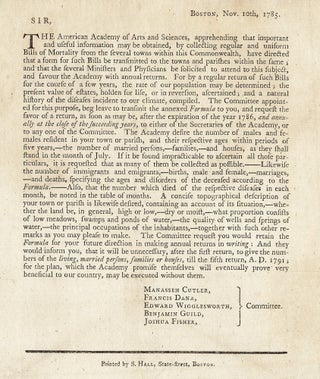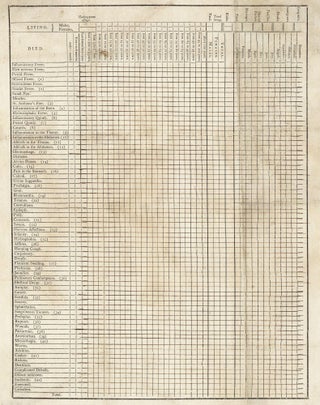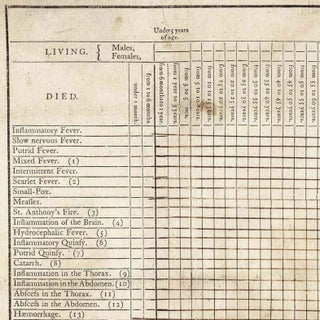IN forming the annexed catalogue of diseases, particular pains have been taken to render it intelligible. Boston, Nov. 10, 1785
Boston: Printed by S. Hall, State-Street, 1785. Letterpress broadside on laid paper, comprising a large table and one column of text. Horizontal lines in table largely hand-ruled in ink. Printed area 16”h x 18 ”w on an 18” x 22 ”w sheet, untrimmed. A remarkable and extremely rare broadside developed in 1785 by the American Academy of Arts & Sciences for a remarkably ambitious mortality survey of Massachusetts towns. BACKGROUND The American Academy of Arts and Sciences was (and is) an honorary society chartered in 1780 by the Massachusetts General Court with the broad mission, “to cultivate every art and science which may tend to advance the interest, honor, dignity, and happiness of a free, independent and virtuous people.” Early members included luminaries of the American political and intellectual scene, among them (of course) Washington and Franklin, but also clergymen such as Manasseh Cutler (1742-1823) and Edward Wigglesworth (1732-94); lawyer and politician Francis Dana (1743-1811); Boston bookseller Benjamin Guild (1749-92), and Beverly physician Joshua Fisher (1748-1833). Probably in 1785, the Academy charged a committee consisting of these five men to conduct a survey of Massachusetts and New Hampshire towns for the purpose of compiling statewide mortality data. The project seems to have been the result of pre-existing interest among the membership in the use of bills of mortality as raw data for demographic and epidemiological studies. On May 29, 1781 committee member Cutler gave a talk at the Academy about “a meteorological journal of the weather, from July, 1780, with the diseases most prevalent in Ipswich, Beverly, and Salem” (Cutler & Cutler, p. 85). And Volume I of the Academy’s Memoirs (1785) included a submission from Edward Holyoke, M.D. titled “A Bill of Mortality for the Town of Salem, for the Year 1782” (pp. 546-550). However the driving force may have been Wigglesworth (1732-1794), Hollis Professor of Divinity at Harvard, who had a long-time interest in demography. During the crisis of 1775 he had published Calculations on American Population, with a Table for estimating the annual Increase of Inhabitants in the British Colonies (Boston: John Boyle, 1775). This interesting little work used estimates of population growth during the Colonial era to reach the conclusion that within a few decades the American would far outstrip that of Great Britain. And for Volume I of the Academy’s Memoirs he contributed “Observations on the Longevity of the Inhabitants of Ipswich and Hingham, and Proposals for Ascertaining the Value of Estates Held for Life, and the Reversion of Them” (pp. 565-568.) The potential epidemiological value of the Academy’s mortality survey is clear, but the title of Wigglesworth’s article highlights the financial and legal utility of the research, for determining “the present value of estate, holden for life, or in reversion.” As he explains: “The value of those estates which are held for life, and the reversion of them, can only be determined by knowing the probability which there is, that their respective holders will live for a longer or shorter term of years.” (p. 567) Hitherto, however, “Whenever a widow has compounded with the heirs of an estate for sum of money in lieu of her dower, the composition has been made at random, and not on any fixed principles that have determined it to be equitable.” (ibid.) In essence, therefore, the collected mortality data would make it possible to construct actuarial tables to facilitate more evidence-based—and therefore more fair—valuation of estates. THE BROADSIDE The five-man committee seems to have taken its assignment seriously, as it developed a standardized and extremely detailed broadside questionnaire with which to solicit mortality statistics from each town in the Commonwealth. Offered here is an example of the form, one of only two that we have been able to locate. It consists of three sections, including at lower right a circular letter with instructions, signed in type by the five committee members; at left a very large table occupying roughly three-fifths of the sheet, to be used for recording the data; and at upper right brief notes explaining dozens of the disease states named in the table. The circular, dated Nov. 10, 1785, states the purpose of the project: apprehending that important and useful information may be obtained, by collecting regular and uniform bills of mortality from the several towns within this commonwealth, have directed that a form for such bills be transmitted to the towns and parishes within the same; and that the several ministers and physicians be solicited to attend this subject, and favour the academy with annual returns. For by a regular return of such Bills for the course of a few years, the rate of our population may be determined ; the present value of estate, holden for life, or in reversion, ascertained ; and a natural history of the diseases incident to our climate, compiled. The large table itself is fascinating. Across the top are cells for entering basic demographic data for each town, including population figures broken down by age and gender, numbers of births, marriages, houses, &c. Below this, the left column comprises a list of 68 causes of mortality, ranging from the familiar (cancer and diabetes) to the unfamiliar (St. Anthony’s Fire, “sphacelation” and “flatulent swelling”) to the hopelessly vague (“complicated diseases”). Across the top are categories allowing the mortality data to be broken down by age (from “under 1 month” to “above 100 years”), gender, and month of death. In all, assuming my count is correct, the table runs to some 2814 individual tiny cells, rendering its completion a wildly impractical task for all but the most committed demographer or epidemiologist. 500 copies of the broadside were printed and distributed to ministers and physicians throughout Massachusetts and New Hampshire, and the survey was also published in local newspapers. The response was alas meager, and by 1789 but 62 bills of mortality had been received, listing in aggregate fewer than 5000 deaths. This hardly seems surprising, given the complexity of the questionnaire. Indeed, even among those who did respond, few made use of the broadside. (Vinovskis, p. 578) Meager as his data set was, Wigglesworth published in 1793 in Volume 2 of the Academy’s Memoirs, under the title “A Table shewing the Probability of the Duration, the Decrement, and the Expectation of Life, in the States or Massachusetts and New-Hampshire…” For all its limitations, this work seems to have had long-lasting influence, as it “was used as the basis for computing longevity in annuity cases by the Massachusetts Supreme Court and is being used by demographers and economic historians today.” (Vinovskis, p. 571) In spite of the substantial print run, the broadside appears to be extraordinarily rare: We find no record of another example having appeared for sale, and have so far confirmed but a single institutional holding, at the Library of Congress. It is likely, of course, that one or more examples reside in the records of the American Academy of Arts and Sciences, and perhaps a few others are hidden for now in the collected papers of late 18th-century New England clergymen and physicians. A remarkable and extremely rare artifact of an attempt at a very early, possibly the first, epidemiological survey in the United States, commissioned by one of the country’s leading learned societies. REFERENCES: ESTC #W69. Evans, Early American Imprints, #18901. Ford, Broadsides, #2401 (Library of Congress only). National Library of Medicine (U.S.), Early American Medical Imprints, #32. Extensive background on Wigglesworth from Maris A. Vinovskis, “The 1789 Life Table of Edward Wigglesworth,” The Journal of Economic History, vol. 31 no. 3 (Sept. 1971), pp. 570-590.[6] Some background on Manasseh Cutler from William Parker Cutler & Julia Perkins Cutler, Life Journals and Correspondence of Rev. Manasseh Cutler, LL.D. (Cincinnati: Robert Clarke & Co., 1888). Offered in partnership with Boston Rare Maps of Southampton, Mass.
Item #5474
Sold





